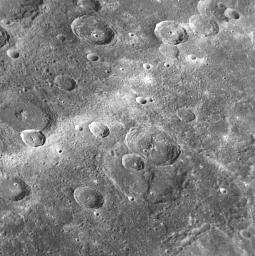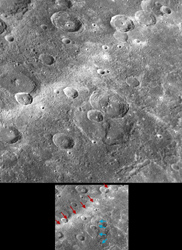
|
A Rupes and a Ray
- Click the image above for a larger view
- Full-Res JPEG (1018 x 1023) (233.6 kB)
- Full-Res TIFF (1018 x 1023) (1.0 MB)
Caption:

Click on the image
for the larger view
In the lower center of this NAC image, a scarp cuts through two craters (blue arrows). The fact that the scarp transects the craters indicates that it formed after the two crater-forming impact events. Many similar scarps (see PIA11012 ), referred to as rupes, have been identified on Mercury, and rupes are believed to have formed when the interior of Mercury cooled and the planet shrank slightly. The white stripe that cuts diagonally across this NAC image (red arrows) is part of a system of rays emanating from a bright, relatively young crater to the north (see PIA11356 ). This impressive ray system extends for large distances over Mercury's surface, as seen in the global image captured during MESSENGER's second Mercury flyby (see PIA11245 ).
Date Acquired:
October 6, 2008
Image Mission Elapsed Time (MET):
131771608
Instrument:
Narrow Angle Camera (NAC) of the Mercury Dual Imaging System (MDIS)
Resolution:
210 meters/pixel (0.13 miles/pixel)
Scale:
This image is about 210 kilometers wide (130 miles)
Spacecraft Altitude:
8,100 kilometers (5,000 miles)
Background Info:
These images are from MESSENGER, a NASA Discovery mission to conduct the first orbital study of the innermost planet, Mercury. For information regarding the use of images, see the MESSENGER image use policy .
Cataloging Keywords:
| Name | Value | Additional Values |
|---|---|---|
| Target | Mercury | |
| System | ||
| Target Type | Planet | |
| Mission | MESSENGER | |
| Instrument Host | MESSENGER | |
| Host Type | Orbiter | |
| Instrument | Mercury Dual Imaging System (MDIS) | |
| Detector | Narrow Angle Camera (NAC) | |
| Extra Keywords | Crater, Grayscale, Impact | |
| Acquisition Date | ||
| Release Date | 2008-11-24 | |
| Date in Caption | 2008-10-06 | |
| Image Credit | NASA/Johns Hopkins University Applied Physics Laboratory/Carnegie Institution of Washington | |
| Source | photojournal.jpl.nasa.gov/catalog/PIA11761 | |
| Identifier | PIA11761 | |
